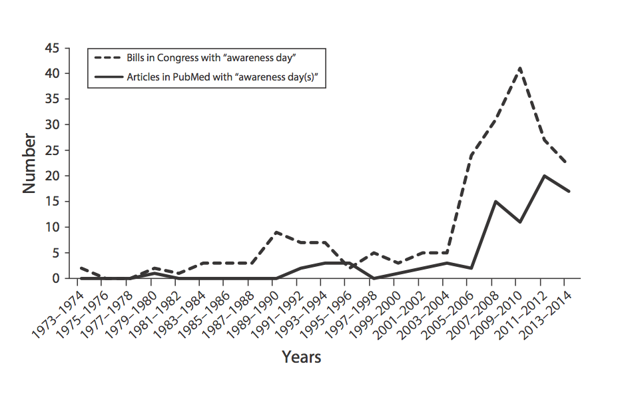Awareness months and days continue to grow each year because health awareness continues to grow.
The United States has almost 200 official awareness months and days. And that’s not counting all the unofficial ones. Here is a list of just the major months.
- January – Cervical Cancer Awareness Month
- February – American Heart Month
- February – Teen Dating Violence Awareness Month
- March – Colorectal Cancer Awareness Month
- April – Alcohol Awareness Month
- May – National Physical Fitness and Sports Month
- May – Melanoma/Skin Cancer Detection and Prevention Month
- June 27 – National HIV Testing Day
- June – National Safety Month
- August – National Immunization Awareness Month
- September – National Childhood Obesity Awareness Month
- September – Fruits & Veggies – More Matters Month
- October – National Breast Cancer Awareness Month
- November – American Diabetes Month
- December 1 – World AIDS Day
Like a birthday or anniversary, having a time set aside during the calendar year gives some assurance a topic will receive attention. Awareness months are a way for organization to stake a claim and establish “we’re here.”
Do awareness months and days work?
Do awareness months and days work?
Here are 6 best practices for awareness months and days.
- DEFINE SUCCESS: National Breast Cancer Awareness Month raises an estimated $6 billion dollars a year. The ALS Association raised $115 million in one month with the Ice Bucket Challenge and helped scientists discover a new gene tied to ALS. Hearing Awareness Month is for the over 36 million American adults have some degree of hearing loss. The goal is to get them to have their hearing checked at an audiologist. Whatever your vision of success is, make sure you have established goals. And take a strategic approach to how you get there. Is it a big win? Or a series of small victories that add up?
- MAKE IT EASY TO PARTICIPATE: October is National Cyber Security Awareness Month from the Department of Homeland Security. They promote weekly education, a slogan (Stop. Think. Connect) and simple ways to participate with 10 best practices. They are: 1) Surf Only on Secure Connection, 2) make smarter passwords, 3) stay up to date on updates, 4) set up authentication, 5) utilize technology, 6) know fact from fiction, 7) don’t open sketchy files, 8) log out of everything, 9) back up information and 10) talk to your family. This are simple way to raise awareness and get involved.
- BE EXPLICIT ABOUT ACTIONS: Don’t assume an awareness month is going to create any actions unless you tell people exactly what you expect them to do. One of the reasons the Ice Bucket Challenge was such a success was the ALS Association was very explicit about what they wanted people to do by telling people: How do I participate in the ALS Ice Bucket Challenge?
- ACCEPT: Accept the challenge;
- RECORD: Take a video of yourself dumping a bucket of ice water over your head to increase awareness of ALS;
- UPLOAD: Upload your video to social media, tagging/challenging at least three of your friends;
- GIVE: Make a donation to support the ALS community.
- SECURE PARTNERS: Long standing awareness months can’t make it without partners. The National Breast Cancer Foundation, for example, actively solicits partners on an on-going basis by letting them know: 1) About NBCF, 2) our programs and 3) how you can help. The latter shows way individuals to corporate partners can get involved
- CREATE TOOLKITS: Healthfinder.gov provides toolkits for several National Health Observances. The toolkits provide resources for organizations like schools, healthcare providers, health departments, and more to raise awareness about critical public health issues, like the importance of early detection of breast cancer. Whether you have government resources or you’re doing it on your own, materials that can be given out to educate and instruct are a requirement.
- THINK INTO THE FUTURE: Awareness months are created for the long term. They require human capital, financial resources, support for many sources and measurement. As a result, you should be clear about what success looks like and how you apply learning to the next year.
If your organization is up for the task, awareness months can be an important annual addition to business planning. Do these best practices show you how awareness months work?

